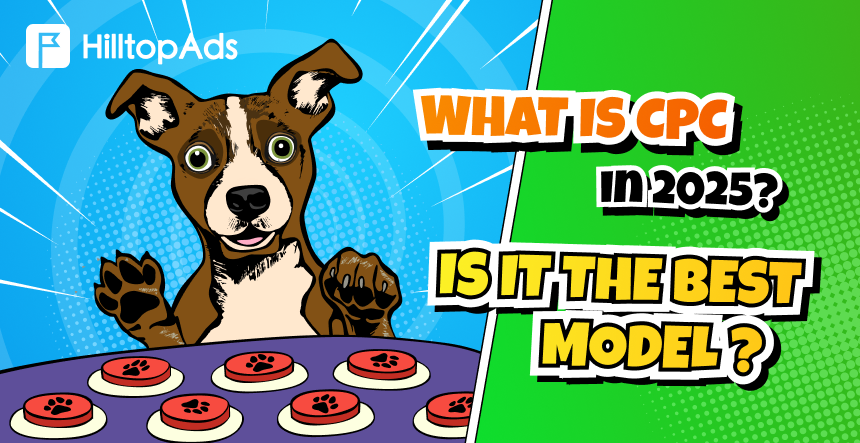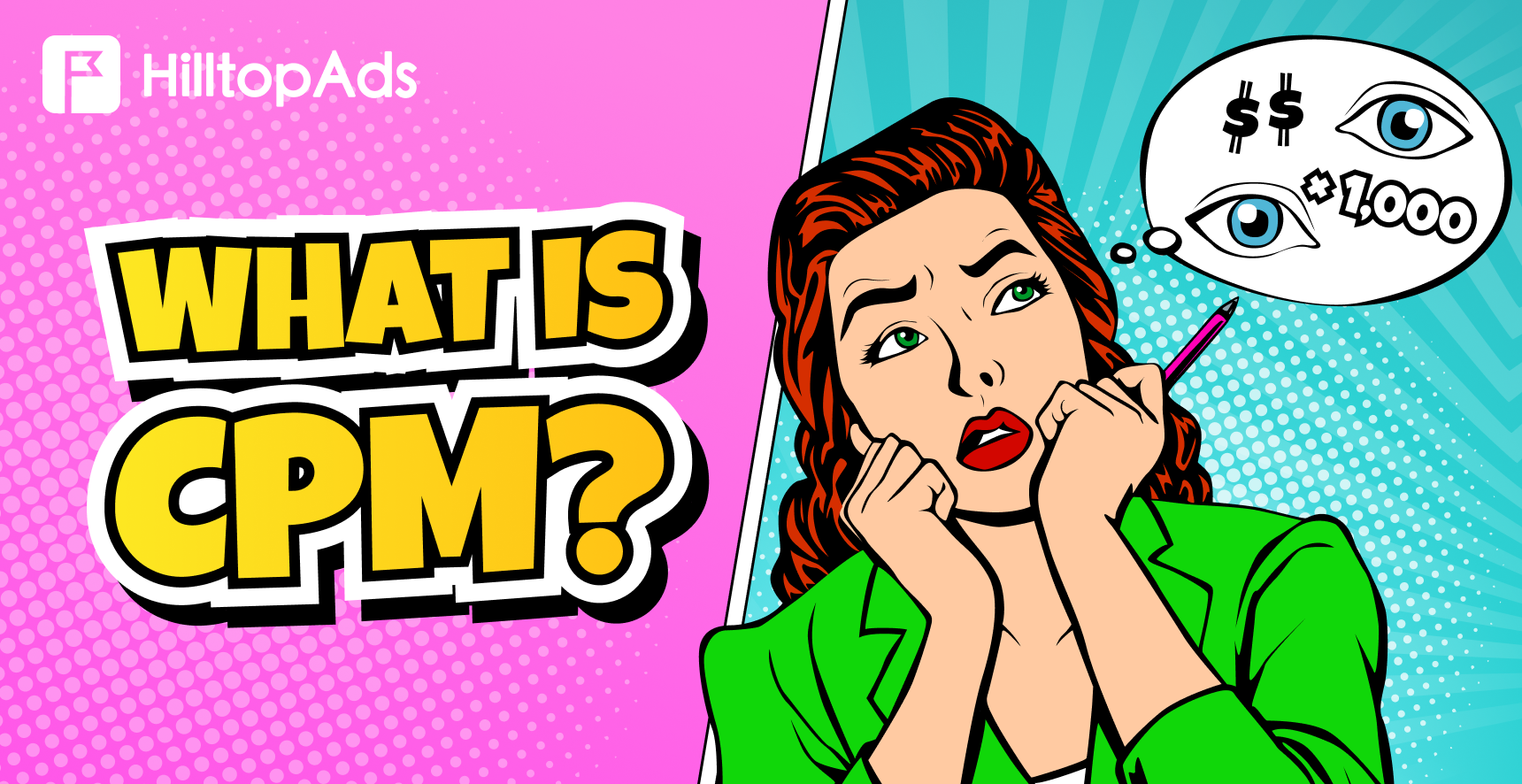Cost Per Click (CPC) is a fundamental bidding model in digital marketing, enabling advertisers to buy ad spots, display their ads, and pay only for actual engagement. There are other models available, but this one in particular remains a popular choice, regardless.
In this article, we will elaborate on the pros and cons of CPC, share expert insights, and guide you on how to approach the model and maximize your earning potential in 2025, while avoiding common pitfalls such as overspending on ads or missing your target audience.
What is CPC: Meaning And Its Role in Digital Marketing
In a pay per click (a.k.a., cost per click) advertising strategy, as an advertiser, you pay only when a user clicks on your ad, appearing on the results pages of search engines, social media, websites, or other platforms. Clicks are a solid indicator that your ad has caught people’s interest, but they tend to be more expensive than impressions under CPM (Cost Per Mille). The basic formula to calculate your CPC is:

Nowadays, CPC is among the most popular ad bidding models. Major platforms, ranging from Google and Facebook to ad networks, support it. The CPC model tends to generate the most clicks, meaning you get a highly engaged audience.
CPC vs CPM vs CPA: What Should You Choose?
Choosing between CPC, CPM, and CPA is like selecting the best tool for the job — it all depends on what you’re attempting to accomplish. If you’re just getting started and need to make your brand stand out, CPM is your best bet. You pay for views, not clicks, which is great for attracting the attention of potential visitors (even if they don’t rush to your website).
However, if you need traffic, such as getting people to visit your site or check out a product, cost per click is a safer option. You only pay when someone clicks, so that people are at least a little invested and looking forward to knowing the details.
Now, if you’re all about results, sales, sign-ups, downloads, CPA is the move. It’s the “I’ll pay you after the job’s done” approach. Perfect if you’re not ready to take the risk or working with a tight budget.
But ultimately, there’s no magic formula. Think about what is a top priority at the moment: brand awareness, website traffic, or conversions? Test one, see how it works with your audience, and don’t be afraid to mix and match. Sometimes you need a little bit of everything to make it work.

Run CPM, CPC, or CPA ad campaigns at HilltopAds
And boost your ROI!
Expert commentaries
When does CPC outperform CPM, CPA, and CPV?
That depends on various factors. In digital advertising, CPC tends to outperform impression-based buys (cost per mille and cost per view). Whenever each click you earn holds measurable value, you only pay when someone engages with your ad, which is perfect for campaigns focused on real traffic and direct response rather than pure visibility.
It’s also a smarter pick than CPA when you’re launching a new offer or don’t yet have enough conversion data to meet the minimums, since you can start with CPC to test headlines, creatives, and audience segments before moving to a pay per acquisition model.
Even versus CPV for video ads, cost per click can win when your goal is to drive viewers from the video to a landing page.
Advertisers are generally better off buying on a cost per click basis when they need tight cost control, are experimenting with new creatives or micro-conversion goals (such as newsletter sign-ups, trial downloads, etc.), or simply want to cap their spend per engagement.
By setting bid ceilings based on historical click-to-conversion rates and continuously refining your targeting and ad copy, you hedge against low conversion rates, make every dollar work harder, and ensure your budget funds only the clicks that truly matter.
Depending on your goals, you must always test different models.
Advantages and Disadvantages of CPC
Knowing the benefits and drawbacks of CPC marketing in 2025 is essential, regardless of your level of experience. Now let’s explore what makes cost per click a headache or a hero.
Advantages
Improved control over your cash flow
You may set a spending limit and only get billed when a user clicks. This is invaluable for new or specialized enterprises. You can even adjust the cost of bidding on an hourly basis with platforms like Google Ads, which makes them ideal for capitalizing on trends.
Better analytics
CPC is a very transparent and intuitive model. If you are focused on increasing return on investment (ROI), this model will help you collect and process tons of data.
Relative safety when trying out new approaches
While cost per click rates are higher than those of CPM, it’s a warranty against wasting your budget on non-converting impressions. If you are confident in your conversion rate (CR), then CPM might be a better pick. However, do you always feel confident about your CR?
Free Branding Perks
Even if people don’t click, they see your ad. That’s free brand advertising. Your logo popping up for “best running shoes” searches — it builds trust before users even land on your site.
Start working on the CPC model with HilltopAds!
Disadvantages
Cost can be high
Bidding wars are brutal, especially when it comes to short-tail keywords. Industries such as cryptocurrency or cybersecurity are squeezing out smaller players. It’s like renting billboard space in Times Square — excellent exposure, but your wallet will feel the burden of the cost.
Click fraud and stealing
Bots and sneaky competitors still drain the budget. Yes, platforms have improved their fraud detection capabilities and provide capping options, making things easier, but it’s a disadvantage nonetheless.
Clicks ≠ Cash
A clicking user is engaged, but nothing more. There is no guarantee they are ready to spend money or complete your target action. In this regard, a high Click-Through Rate (CTR) can be misleading. All your funnel elements must work like clockwork or you end up acquiring and losing costly clients instead of converting them.
What Is CPC for Advertisers, and Why Is It Important?
No one rides for free, and ad spots are no exception. As an advertiser, you can rely on cost per click or any other bidding models to pay for showing your ads. CPC doesn’t generate money directly for advertisers, but it affects your costs. Depending on how much your affiliate network pays, you can either cover them or not. To make sure you’re in the black, we’re here with some suggestions and tips.
When to Use CPC
Cost per click works best when you want people to take a specific action, like visiting your website or checking out a product. For example, if you’re promoting a new blog post, running a sale, or trying to get sign-ups for a webinar, paying per click filters out disinterested users by design.
It’s also great for e-Commerce brands (think Amazon or Shopify ads) because you can send shoppers directly to product pages. Retargeting campaigns often use CPC too — if someone already browsed your site, they’re more likely to click an ad and come back. Additionally, if you’re on a tight budget, CPC helps control costs since you’re not paying for ads that people simply scroll past.
Expert commentaries
What should you pay attention to when working with CPC?
When you’re running CPC campaigns, the first thing to keep an eye on is ad relevance and Quality Score. Make sure your headline, description, and landing page all speak the same language. When Google or Facebook sees that alignment, they reward you with lower actual CPCs.
Next, watch your click-through rate: a low CTR often signals that your targeting or creative isn’t resonating, so tweak your audiences, try new images or copy, and trim out underperforming keywords.
Don’t forget negative keywords too! Blocking irrelevant searches saves you from paying for clicks that will never convert.
Speaking of conversions, always correlate your CPC with your conversion rate. A high CPC can still be cost-effective if it brings quality traffic that converts at a healthy rate. If you notice your cost per acquisition creeping up, it might be time to refine your landing page or adjust bid modifiers by device, location, or time of day to reach your sweet spot.
And keep an eye on frequency, if you’re retargeting the same person too often, you waste impressions and risk annoying them. A cap of three exposures in 24 hours is a good starting point.
Finally, pace your budget to avoid burning out early in the day, and don’t shy away from automated bidding strategies once you’ve gathered enough data.
They can help you hit your target CPC or CPA without constant manual tweaks. With these checks, relevance, CTR, conversions, and pacing, you’ll turn CPC into a nimble, measured way to drive the clicks that matter.
Start working on the CPC model with HilltopAds today!
- Advanced targeting options
- Direct traffic sources
- Self-serve platform
- Fully-managed service
- Postback tracking
- Direct traffic sources
The CPC model is good in such scenarios where the goal isn’t just to boost brand visibility but to drive specific, actionable responses from users — attracting clicks and prompting immediate engagement.
This approach is commonly used with formats like banner ads and in-page push notifications. Success hinges on three key elements: a clear and compelling offer, eye-catching creatives, and a precisely targeted audience.
CPC is particularly effective for campaigns focused on:
- Lead generation
- Subscriptions
- Mobile app downloads
- e-Commerce promotions
How to Track CPC Campaigns
Start by watching the three primary metrics:
- Click-Through Rate (CTR) — clicks divided by impressions show your actual performance and can justify high bidding rates if it’s also on par.
- Cost Per Click (CPC) — divide your total ad spend by the number of clicks, and yeah, you need data to calculate this metric — that’s one of the reasons to run tests first. If your CPC is $0.50, that’s what you pay each time someone clicks.
- Conversion Rate (CR) — not every click leads to a sale or sign-up. Track how many clicks turn into actual results, like purchases or form submissions, to see if your landing pages or offers are working. This metric helps you understand what’s happening with your funnel at a deeper, post-click level.
Tools like Google Ads or Facebook Ads Manager will show these metrics, but you can also use Google Analytics to dig deeper. Try testing different ad versions, such as changing headlines or images, to see which one performs best.
Expert commentaries
The CPC model’s success relies on several factors:
- Compelling creatives that maximize CTR by instantly grabbing attention
- In-depth traffic analysis to identify high-performing placements and eliminate budget-draining sources
- Rotating 3-5 different ad designs and CTAs to avoid creative burnout
- Ensuring seamless alignment between ad messaging and landing page content to maintain user trust
- Optimizing for eCPA rather than just CPC to prioritize post-click actions like purchases or sign-ups
- Filtering out low-quality sites through blacklists/whitelists
- Employing targeted parameters (geo, device, interests) to sharpen audience focus
All this should work together seamlessly to drive cost-efficient, high-converting campaigns.
Tips to Reduce CPC
CPC advertisements can quickly deplete your budget if done wrong. However, with the right hacks, you may lower costs and improve performance. Here are several 2025 tactics — no tricks, just practical measures.
Search for long-term words
Avoid using broad terms such as “running shoes.” Use more precise language instead — “women’s waterproof trail runners size 9.” These long-tail keywords are cost-efficient, boast milder competition, and attract high-intent buyers who are willing to do business rather than window shopping.
Focus on increasing your Quality Score
Google’s Quality Score is important. Improve yours by:
- Matching ad copy to landing pages (e.g., if your ad says “organic dog food,” don’t send users to a generic pet supplies page).
- Accelerating your website. Lower CPCs are awarded to pages that load in less than two to three seconds. Upgrade your hosting or utilize tools like PageSpeed Insights.
- CTAs and A/B testing. Quality Score increases after switching from “Shop Now” to “Get 50% Off Today.”
Don’t bid mindlessly
Even a simple task, such as bidding, takes a good strategy to work.
- Location targeting — eliminate areas with low conversion rates and save your budget.
- Ads should only be run during peak conversion times (e.g., a meal kit service targeting dinner planners between 5:00 and 7:00 PM).
- Device bidding — if desktop accounts for 80% of your sales, place lower bids on mobile.
Take advantage of competitor weaknesses
Use spy tools to gather data on competitors’ keywords and ad copy. Then, take advantage of what they’re overlooking. Avoid using trademarked terms to prevent legal issues.
Retarget
Retargeting tends to have lower CPCs because you’re concentrating on already warmed-up leads. Show clients who have viewed specific products or abandoned their carts dynamic ads to re-engage them.
Supervise AI
Allow AI to manage time-consuming operations, such as bid adjustments and keyword sorting, while maintaining human supervision of strategy. For example:
- Use ChatGPT to generate 50 ad headlines in seconds, then select the top three.
- Platforms such as Google’s Performance Max optimize campaigns automatically, but review placements weekly to block junk sites.
- AI can also help to generate tons of royalty-free and exclusive creatives
Expert commentaries
How to find the best CPC rates
Finding the sweet spot for CPC is really about data, testing, and honest partnerships. Advertisers should begin by getting real benchmarks; for instance, WordStream reports a $4.66 average CPC on Google Search in 2024. Then, you dig into your own account’s Auction Insights and bid estimators to see where you sit versus the competition.
Launch small tests across different keywords, placements, or audience segments, and watch which clicks actually convert.
Once you’ve gathered enough data, switch to an automated bid strategy that chases your target cost per click or cost per acquisition without you staring at dashboards all day.
On the flip side, publishers can’t just sit back hoping for high CPC bids. You need to know the floors your ad networks guarantee, compare them against what header bidding auctions bring in, and weed out underperforming partners.
Boost your own CTR and viewability by placing ads in hot zones and making sure they load fast. The higher your click-through rates, the more fiercely advertisers will bid, and the more you earn per click.
To make both sides happy, consider hybrid or transparent models: a minimum CPM floor protects publishers from extremely low bids, while a CPC share above that floor rewards them for actual performance.
Direct negotiations, such as those with affiliate advertisers you’ve vetted on affiliate program platforms like affnext.com, allow you to agree on a bid ceiling and a revenue share split. Therefore, advertisers never exceed their CPC budgets, and publishers consistently meet the agreed-upon yield. In the end, data transparency and shared incentives turn the classic CPC conflict (advertisers fearing runaway click costs vs. publishers fearing revenue dips) into a true performance partnership.
What is CPC in HilltopAds?
HilltopAds offers multiple bidding models for your use: CPM, CPC, CPA, etc. With our Cost Per Click model, you receive targeted traffic, paying only for real engagement. When it comes to ad formats on a CPC basis, you can use in-page pushes, banners, or video ads.
If you have already run a CPM campaign and received tons of impressions, then a CPC campaign is an ideal follow-up. This way, you re-engage the users, who saw your ad but didn’t act the first time — sometimes all you need is a little nudge to get a massive influx of otherwise wasted traffic. When working with CPC, advertisers can focus on generating clicks from a warmed-up audience to save on budget and maximize their conversion rate (CR).
Moreover, at HilltopAds, we combat all forms of ad fraud by implementing cutting-edge solutions to ensure every click of yours counts. Advertisers can be confident that they are paying only for genuine clicks from real users, without bots or incentivized traffic. Register now to discover how we streamline processes and optimize your conversion potential.

Use HilltopAds tools to create effective advertising campaigns!
Expert commentaries
Which ad formats rely on CPC, and which ad campaigns benefit from it?
Generally, I’d say Push Notifications charge you per click, while pop up and pop under ads typically bill by the thousand impressions or CPM. But beyond those two, almost every performance-driven format you’re likely to run on today’s platforms uses CPC.
When you bid on search campaigns in Google or Bing, you choose your keywords and only pay when someone actually clicks your link. The same goes for social media ads on Facebook, LinkedIn, or Twitter: you set your maximum cost per click and let the algorithm deliver clicks at the best price it can.
Native ads, those sponsored stories woven into articles or recommendation widgets, also almost always charge per click, so publishers know they’re only earning when real engagement happens.
Even product listing ads (think Google Shopping) and many display buys through demand-side platforms (DSP) let you switch to a CPC model if your goal is traffic or conversions.
And when you’re retargeting past visitors, it’s virtually always CPC, since you’d rather pay for a warm lead clicking back to your site than for another impression they might ignore.
If you’re running conversion-focused push campaigns, launching a flash sale, bidding on high-intent search terms, or serving affiliate promotions, like those you can find lined up on affnext.com, you only pay when someone takes the extra step to click through.
What is CPC: Closing Thoughts
In 2025, CPC advertising remains a go-to strategy for businesses seeking clear expenses and predictable results. Setting daily budgets, tracking clicks in real time, and reaching specific audiences make it a practical choice.
That said, higher ad costs in crowded markets and the risk of fake clicks mean advertisers must always be vigilant. Tools powered by AI now help automate bids and refine targeting, while privacy-focused tactics and interactive ads keep campaigns engaging without compromising user trust.
To maximize the effectiveness of cost per click, many brands pair it with performance-based models, such as CPA, or broader brand-awareness tactics, like CPM. Businesses that test, stay up-to-date with the data, and remain transparent with their audiences will continue to see CPC deliver value, even as the digital ad landscape shifts around them.
Expert commentaries
Extra tips, comments, and suggestions about CPC.
First, don’t get hung up on your raw cost per click; what really matters is how those clicks translate into revenue. Track your return on ad spend (ROAS) or earnings per click (EPC) alongside CPC so you know if your bids are sustainable.
Tie everything back into a multi-touch attribution model so you can see which channels and campaigns deserve your budget, instead of assuming the last click gets all the credit.
Next, remember that not all clicks are created equal. A vanilla search click might cost the same as a mobile in-feed click, but if one converts at twice the rate, you should be bidding higher there.
Use device and demographic bid adjustments to pay up where performance is proven and dial back where it’s not. Seasonal shifts matter too: your “good” CPC during Black Friday prep will look different than in a slow January.
Don’t be afraid to peek under the hood with your platform’s bid simulators. These tools show you how boosting your max CPC by a few cents could impact your impression share and overall spending.
And when you’ve got a solid performance history, consider handing the wheel to automated bidding or AI-driven strategies that chase your target CPC or ROAS around the clock.
Finally, always tighten your targeting: negative keywords and audience exclusions are your best defense against bots, accidental clicks, and individuals who are unlikely to convert.
If you’re an affiliate marketer, you can even scout out affiliate networks and publishers on affnext to find partners whose audiences match your offers, often at CPC rates you won’t see on the big, crowded exchanges.
With the right mix of data-driven tactics, creative testing, and strategic partnerships, CPC becomes not just a way to buy clicks, but a finely tuned engine for profitable growth.
Expert commentaries
Effective CPC campaigns require a relentless focus on real-time metrics, such as CTR, conversions, and ROI. Attention to landing page quality is also crucial — even exceptional creatives fail if they either are poorly designed or send to non-responsive pages that don’t adapt to devices or audience segments. Avoid blind traffic purchases by using trackers, UTM tags, and postbacks to trace user journeys. Continuously A/B test creatives, as even minor elements like call-to-action button colors can significantly boost CTR and conversions. Simultaneously, analyze post-click behavior (time on site, navigation patterns, and goal completion) to refine strategies and prioritize eCPA over raw CPC data, assessing the actual value of the campaign. This cycle of testing, analyzing, and optimizing is what defines profitable CPC campaigns from wasted money and time.





















